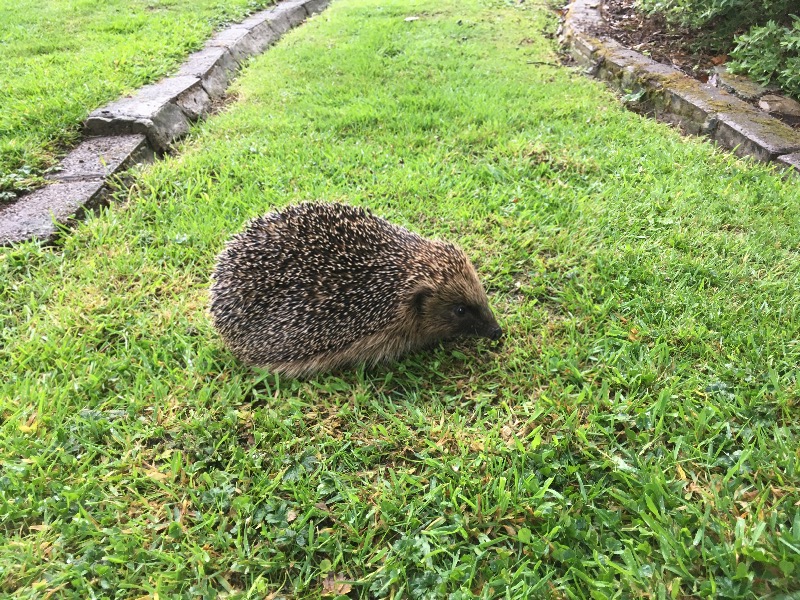Ms. Deery’s Welly Wednesday
Hello Everyone,
I hope that you are all doing really well and getting ready for your holidays from school. This week I didn't have to go too far in my Wellies as I spotted this little guy at the bottom of the garden- a Hedgehog.
I couldn't believe that I could be so lucky and that I was able to capture him on video for you.
Hedgehogs are famous for their prickly spines, which they have everywhere except on their face, legs and bellies. They use their spines for defense, both while they sleep and when they face enemies. By curling into a tight ball and tucking in their heads, tail and legs, they protect vulnerable parts of their body.
The body of adult hedgehogs ranges from 14 to 30 centimeters long, and their tail can add one to six centimeters. When they are born (there can be up to seven in a litter) their spines are soft and short. But soon after birth, their spines harden, becoming stiffer, sharper and longer. Babies stay in the nest until they are about three weeks old. By that time, their eyes are open, their spines are effective and they can safely follow their mother outside the nest as she looks for food.
Top on the hedgehog's menu are insects, followed by small mice, snails, lizards, frogs, eggs and even snakes. Mostly nocturnal creatures, they head out at night in search of food – but they are sometimes active during the day, too, particularly after it rains.
Hedgehogs have a trick up their, errr, “sleeve” to give themselves extra protection – “self anointing.” These amazing animals are immune to certain poisonous plants, which they eat before making a frothy saliva in their mouth. The hedgehogs then lick their spines, spreading the saliva with the plant's poison all over the spikes. Scientists believe this may help hedgehogs hide their scent from predators, or give them a nasty shock shock should they attack!
There are 15 different species of hedgehog, found across Europe, Asia and Africa. Whilst these cool creatures mainly stay on the ground, they are quite good swimmers and can climb trees, too!
Here are some more interesting facts about Hedgehogs:
1. They are nocturnal
Hedgehogs are nocturnal which means that they sleep in the day and only come out at night.
2. They are called hedgehogs for a reason
The ‘Hedge’ part of their name comes from where they build their nests hedges, bushes and shrubs. The ‘hog’ part comes from the small snorting/ grunting sound they make which is similar to a pig/warthog.
3. Hedgehogs can hibernate
Hedgehogs have the ability to hibernate (although not all do). Hibernating means that they hole themselves up and stay in a dormant state for winter, it's like a big long sleep.
4. Hedgehogs are lactose intolerant
Hedgehogs are actually lactose intolerant, so milk should never be left out for them, water is perfectly fine.
5. They weren’t always called hedgehogs
The hedgehog was not always called a hedgehog. Before this they were called Urchins which led to the naming of Sea Urchins.
6. Their long snout is useful
Hedgehogs have a really long snout to help them hunt. It is even ahead of their mouths as it makes it easier to forage for their staple diet of insects, worms, caterpillars and berries.
7. They don’t use their eyes to hunt
They hunt primarily using they hearing and smell because their eyesight is not very good, although they can see quite well in the dark.
8. There isn’t just one species of hedgehog
There are 15 different species of hedgehog in the world. Each are similar but have small characteristic and habitual differences. Ireland only has one native species, the European Hedgehog.
9. They have over 5000 spikes
Hedgehogs have around 5000 to 7000 spines on their back. These can be raised and lowered to respond to threatening situations. Each quill/ spine lasts about a year before dropping out and being replaced.
10. They have intelligent self-protection
The hedgehog has a vulnerable stomach, which is why it curls up into a spiky ball when predators such as badgers are around.
11. They self-anoint when stimulated
If a hedgehog smells or tastes something really strong, it will attempt to cover itself in foamy saliva, much like a cat cleaning itself. This is called self-anointing.
12. They are solitary creatures
Hedgehogs venture out on their own after only four to seven weeks of nurturing from their mother. They usually then spend their entire lives alone with the exception of pairing up to mate with another hedgehog.
13. A group is called an array
It is extremely rare that you will see multiple hedgehogs together in one place other than when mating, but if you do it is called an array.
14. Hedgehogs are a gardeners’ friend
Hedgehogs have earned this reputation because of their eating habits. Not only do they enjoy berries and fruit but the staple of their diet is made up from pests that are common in our back gardens such as beetles and caterpillars. This helps preserve the fruit and vegetables you may have growing in your gardens.
15. Little legs walk far
When hedgehogs are out to forage in the evening, they can travel for up to 2 miles, that’s a long way for little legs!
Here is a link that you can find out more: https://www.youtube.com/watch?v=yMavW0FNzl4
See if you can spot a hedgehog in your garden or maybe you could draw a picture of one and send it into me.
Have a lovely week everyone.
Lots of love,
Ms. Deery xox
St. Philip the Apostle JNS, Mountview Rd, Coolmine, Dublin 15, Ireland Telephone: 01 8212992









